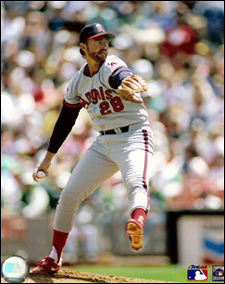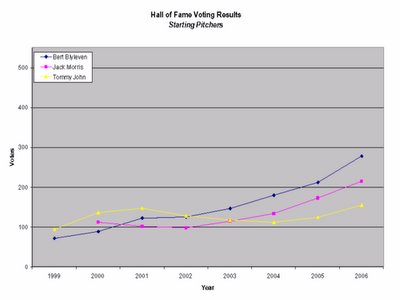Nothing livens up the Winter Baseball Doldrums like a good, old-fashioned challenge trade.
The St. Louis Cardinals are allegedly about to implement just such a trade with the Blue Jays, swapping disgruntled third-sacker Scott Rolen for his couterpart in Toronto, Troy Glaus, who is reportedly not all that gruntled himself.
Rolen, once the preeminent thirdbaseman in the National League, has not had a full, healthy season since 2003, though he played so well in 142 games in 2004 that he finished 4th in the NL MVP voting. The last three years, however, he's been rather injury prone, playing only 56 games in 2005, 142 in 2006 and 112 last year. He first hurt his left shoulder in 2005 in a collision with Hee-Seop Choi, then of the Dodgers, and has had three surgeries on it since. He did manage to play most of the season in 2006, hitting .296 with 22 homers and making his 5th All-Star team, but he slumped badly in the second half of that year, hitting only .253 with 8 homers after the All-Star break. This year, the bad shoulder robbed him of his power, so that he managed only 8 homers all season, and then did not play after August 28th. He had a third surgery on that shoulder and is expected to be ready for Spring Training, but shoulders are notoriously fickle healers, especially thrice-cut shoulders.
Rolen's apparent lack of communication about his injury with manager Tony LaRussa during the postseason in 2006 turned out to be the start of an ongoing feud between the two, one that never has been settled. Both men feel like they've done everything they should do or had to do, and that the other has acted like a petulant child. But of course childish behavior is part and parcel of the world of professional sports, where everyone is fabulously wealthy and constantly surrounded by people telling them that they can do no wrong, so both are to blame.
But LaRussa is the manager who just signed a two-year deal, LaRussa is the manager who brought the Cardinals their first World Series title in a quarter-century, LaRussa is third on the all-time managerial Wins list, and LaRussa is the one that's definitely going to the Hall of Fame someday (unless they find out that his win totals were inflated by something other than bourbon).
So Rolen is the one who had to go.
The trouble with that, however, is that usually nobody wants an oft-injured, 32 year old third baseman who's owed (depending on your source) either $33 or $36 million over the next three years, especially not one who's got a history of feuding with his manager.
Enter the Toronto Blue Jays and their unhappy thirdbaseman. Glaus, however, is not unhappy with his manager, but with the playing surface at Rogers Center (the erstwhile SkyDome). Glaus, too, is coming off a surgery and is expected to be ready for the spring, but in his case, it was his left foot (plantar fascitis) that needed the surgery. His ego, unlike Rolen's, appears to still be intact.
Glaus has had other injury problems as well, including various nagging injuries in 2003 (wrist tendonitis, back spasms, and infected little toe (eewww...)) and a partially torn rotator cuff in his shoulder that wound up costing him about 70 games that year. When off-season rehab didn't fix it, the shoulder needed arthoscopic surgery, and that and other minor injuries (knees, back, hamstrings, etc.) cost him another 100 or so games in 2004 as well. He was pretty healthy the next two years, playing about 150 games in each, but then the heel thing flared up and he missed about 45 games in 2007.
But that's all in the past. Assuming that these players are both reasonably healthy going forward, what can we expect?
Rolen and Glaus, though they play the same position, get their value as players in very different ways. Glaus, for example, does not hit for average, and consistently not. His career batting average is .254, and with the exception of his Y2K season, when he hit .284, he's never been higher than .262 (this year) or lower than .240 (his rookie campaign). He compensates for this with patience and power, averaging 91 walks and 36 homers per 162 games in his career. And though he's shown himself capable of playing shortstop in a pinch, Glaus is generally thought of as a brutal fielder at the Hot Corner, having twice led the major leagues in errors by a thirdbaseman and being last in the AL in Zone Rating each of the last two years.
Rolen, on the other hand, is an excellent fielder, with seven well-deserved Gold Gloves. According to Baseball Prospectus' Fielding Runs Above Average, Rolen has not been worse than +4 FRAA since his first cup of Major League joe in 1996, and since that year has averaged +15 FRAA. Rolen's batting average however has not been as consistent, fluctuating between .235 and .314, though admittedly when healthy he's usually hit .280 or better. Rolen does not walk as much or hit for as much power (averaging "only" 77 walks and 28 homers per 162 games) though he's no slouch in either department. A little more mobile on the basepaths, Rolen hits more doubles than Glaus (averaging 41 per 162 games, compared to just 31 for Glaus). Both men are quite big (6'4" or 6'5", over 240 lbs), bat righty, and at one time stole a few bases but don't any longer.
According to Baseball Prospectus, over the course of his career, Rolen has been roughly twice as good a player as Glaus. He's racked up 83.8 Wins Above Replacement Position (WARP) in 1504 games, which works out to about 9 WARP/162 games. Glaus has only 41.9 WARP in 1244 games, which works out to 5.5 WARP/162. OK, so Glaus is about 60% the player that Rolen is, not half.
But Glaus is more than a year younger than Rolen, and at least for the last three years, has been slightly more valuable than Rolen, if only because he's played more games. Going forward, I don't see any reason that this should change, as Glaus' foot issues should be alleviated by both the surgery and the scenery, while Rolen's likely to start griping about the ToronTurf the first time a reporter sticks a microphone in his face in April. That will alienate the front office and the manager and the players, not to mention the three or four-dozen fans in Toronto, and Rolen will have worn out his welcome in a third city, not to mention a second country.
The thing (I think) nobody is talking about with this trade is that Rolen specifically did NOT sign a long-term deal with the Phillies back in 2002 because he so disliked the hard turf at Veterans' Stadium. It wasn't the money, as they offered him $140 million over 10 years at the time, and it wasn't the team, which had won 86 games in 2001 and was building toward being a perennial choke-artist contender. It might have been the manager, but then Larry Bowa rubs everybody the wrong way eventually, so he shouldn't have taken that personally. It was the turf, and maybe the obnoxious fans. But is there any good reason to expect that Rolen's knees, now five years older and with about 650 more games under them, will be more fond of the turf in Toronto? I don't think so.
Glaus, too, is heading into a sort of bad suituation for him. Of course, he'll be in the relatively soft NL Central instead of the tough-as-nails AL East, so that should help his batting stats a little, but with defense as bad as his, can it be long before a baseball purist like LaRussa gets a little tired of the errors and mis-plays? Glaus has never played the outfield, and he's sure not going to supplant Albert Pujols at first base. The NL does not offer the DH, so LaRussa may have to bench him or take him out for late-game defense if Glaus doesn't improve, which means more hurt feelings and yet another feud. It's just a matter of time.
Another wild card factor for Glaus is that his name came up in the Mitchell Report as one who received steroid shipments from a lab in Florida in 2003 and 2004, when he was with LAnahfornia. Nobody really knows how those allegations will affect the players, whether they'll be roundly booed in visiting stadiums, or even in their own, and how that might hurt their production. Another issue is that, if players like Glaus were still somehow taking something like HGH or steroids last year or the year before, not just in 2003, would the increased scrutiny of being named in the Mitchell Report force them to stop using, and if so, how would that affect their production?
Fortunately for Glaus and LaRussa, Glaus is only signed for two more seasons, totaling about $24 million, so if they're not happy with him, he's gone after 2009.
So, getting back to my self-imposed question of what we should expect from these two in the future...
*UPDATE*: Donald Evans reports that both the ZIPS and Bill James Projections for 2008 have Glaus playing more, between 20 and 30 games more than Rolen, with a better OPS. Bill James has a marginal difference between them (.851 vs. .842) while ZIPS shows a huge difference (.819 for Glaus and only .728 for Rolen). Baseball Prospectus unfortunately does not have their projections available yet.
I suspect that if both men were totally healthy from here on out, the Jays would probably get more out of Rolen for the next two years than the Cards will get from Glaus, mostly because Rolen's bat, while different, is roughly as valuable as Troy's, if not more so, plus he helps a lot on defense, whereas Glaus kinda sucks. Or blows. Or whatever derogatory word you think best describes a lousy defender.
However, I don't think Rolen's shoulder woes are behind him, and I wonder whether he'll even be able to play the full three years remaining on his contract. If that shoulder gets him shut down, or worse yet, nags him just enough to rob him of his power but not enough to get him out of the lineup, then the Blue Jays are stuck with a singles-hitting thirdbaseman who plays decent defense but costs them $33 or $36 million dollars. Through 2010. When he'll be 35. It's like paying for a superstar but getting Mike Lamb or Sean Burroughs for your investment.
Whatever happens, it sure will be an interesting challenge for both sides.












